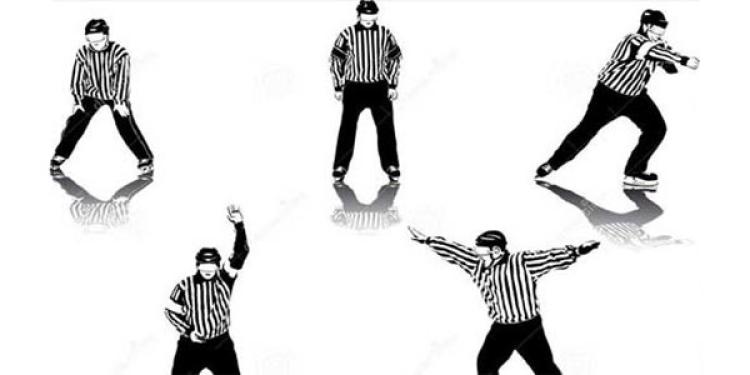The Basic Rules of Ice Hockey – Officials in Hockey
Posted: April 18, 2016
Updated: April 18, 2016

On-ice officials in ice hockey
- Referee(s) (one or two)
- Linesmen or ‘liney’ (one or two)
- Assistant Referees (lower leagues)
Find out what is vital to know about the officials in hockey if you want to bet on the NHL or the IIHF World Ice Hockey Championship!
Enhance your hockey knowledge further with the help of our ice hockey rules guide in order to improve your in-game hockey betting skills! Learn everything that is vital to know about the officials in hockey to understand the game and hockey internet betting easier!
Ice hockey games are usually conducted by three or four on-ice officials with an off-ice crew assisting them. Competitions on the biggest stage use four officials in ice hockey, and they are helped by a complete team next to the ice hockey rink – and sometimes from thousands of miles away too.
On-ice officials in hockey
The on-ice officials in hockey are the referee(s), the linesmen and the off-ice officials. The hockey referees and the linesmen are the guys who wear zebra costumes and skating pretty well all around the hockey rink without a stick. The referees wear an orange armband and they are responsible for calling most of the penalties in hockey. They also throw the puck in center faceoffs at the start of the periods and after goals.
The linesmen’s main job is to watch out for penalties like offside and icing. They call these penalties as well as other minor penalties and also conduct faceoffs after them. Linesmen also interrupt players fighting against each other on ice.
Most leagues and competitions, like the NHL, use four officials in hockey with two referees and two linesmen, however a three-official system with one referee and two linesmen is also well-spread and well-known amongst those, who bet on sports in Canada.
Off-ice officials in hockey
Off-ice officials in ice hockey
- Goal judge
- Video goal judge
- Official scorer
- Penalty timekeeper
- Game timekeeper
- Statistician
The on-ice officials have some assistance from outside the hockey rink, from the so called off-ice officials in hockey. They are the goal judge, the video goal judge, the official scorer, the penalty timekeeper, the game timekeeper and the statistician. And there is also the Situation Room back in Toronto to help them.
The goal judge is watching for goals, possessing a better view than the on-ice crew. They signal goals by turning on a red light behind the net. Their calls can be overruled by the referees, who award goals, not just penalties in hockey. The video goal judge however has the final word in disputed goals after watching the video replay. In the NHL, the final say after reviews often comes from the Situation Room in the Toronto NHL office.

The official scorer has a list of administrative tasks and he is responsible for awarding points for goals and assists. The penalty timekeeper supervises penalties in hockey awarded by the referee. He watches the penalty clock in order to display the correct penalty time and to release players from the penalty box in the right time. Game timekeeper starts and stops the game clock. There is also a statistician to record the required team and player statistics.
In the final piece of our ice hockey rules guide, we will discuss the different penalties, the nature of on-ice fights and we will also answer the question that is always the most interesting one for those who bet on sports in the EU and worldwide: what was the most penalties in a hockey game ever?
The Basic Rules of Ice Hockey
The Basic Rules of Ice Hockey – Offside and Icing
The Basic Rules of Ice Hockey – Checking in Ice Hockey












